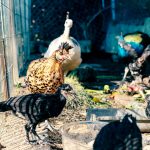Red-tailed hawks (Buteo jamaicensis) are formidable predators that pose a significant threat to chickens. These raptors possess exceptional hunting skills, including sharp vision, powerful talons, and strong beaks, which they use to capture and dispatch their prey. Chickens are particularly vulnerable to red-tailed hawk attacks due to their ground-dwelling nature and limited flight capabilities, making them easy targets for these aerial hunters.
Red-tailed hawks employ stealthy hunting techniques, often utilizing their ability to swoop down from above to catch unsuspecting prey. This hunting strategy is especially effective against free-range chickens in open areas, where they have little protection from aerial attacks. To effectively protect chickens from red-tailed hawk predation, it is crucial to understand the behavior and hunting patterns of these raptors.
By gaining insight into their hunting methods and what attracts them to specific areas, chicken owners can implement appropriate protective measures. Red-tailed hawks are opportunistic predators that target a variety of small animals, including chickens. They are drawn to areas with abundant prey, such as open fields or pastures where chickens may graze.
These hawks are also known for their territorial behavior, often defending their hunting grounds from other predators. Once a red-tailed hawk identifies a location as a productive hunting area, it may return repeatedly in search of prey. Understanding these behavioral patterns can help chicken owners identify potential vulnerabilities on their property and develop strategies to reduce the risk of red-tailed hawk attacks on their flocks.
Table of Contents
- 1 Creating a Secure Chicken Coop
- 2 Using Visual Deterrents
- 3 Implementing Auditory Deterrents
- 4 Employing Physical Barriers
- 5 Establishing a Safe Free-Range Environment
- 6 Seeking Professional Help
- 7 FAQs
- 7.1 What are red-tailed hawks?
- 7.2 Why do red-tailed hawks pose a threat to chickens?
- 7.3 What are some methods to keep red-tailed hawks away from chickens?
- 7.4 Are there any legal restrictions on deterring red-tailed hawks?
- 7.5 Are there any natural predators of red-tailed hawks that can help keep them away from chickens?
Key Takeaways
- Red-tailed hawks pose a threat to chickens as they are natural predators.
- Secure chicken coops are essential to protect chickens from red-tailed hawk attacks.
- Visual deterrents such as scarecrows and reflective objects can help deter red-tailed hawks.
- Auditory deterrents like loud noises or predator calls can also discourage red-tailed hawks from attacking chickens.
- Physical barriers such as netting or fencing can be effective in keeping red-tailed hawks away from chickens.
Creating a Secure Chicken Coop
Designing a Secure Chicken Coop
One of the most effective ways to protect your chickens from red-tailed hawk attacks is to create a secure chicken coop. A well-built coop will provide your chickens with a safe and enclosed space where they can roost, lay eggs, and seek shelter from predators. When designing a chicken coop, it’s important to consider the specific threats posed by red-tailed hawks and take measures to prevent them from gaining access to your flock.
Securing the Coop Structure
To create a secure chicken coop, start by ensuring that the structure is sturdy and predator-proof. Use heavy-duty wire mesh to cover all openings, including windows, vents, and doors, to prevent red-tailed hawks from entering the coop. Additionally, consider adding a roof or overhead covering to the coop to protect your chickens from aerial attacks. This will help deter red-tailed hawks from swooping down on your chickens while they are inside the coop.
Providing a Safe and Comfortable Living Space
In addition to securing the physical structure of the coop, it’s important to provide your chickens with adequate roosting space and nesting boxes inside the coop. This will encourage your chickens to spend more time inside the secure enclosure, reducing their exposure to potential predators like red-tailed hawks. By creating a safe and comfortable living space for your chickens, you can minimize the risk of red-tailed hawk attacks and ensure the well-being of your flock.
Using Visual Deterrents

Visual deterrents can be an effective way to deter red-tailed hawks from targeting your chickens. These deterrents work by creating visual disturbances or illusions that make the area less appealing to predators, ultimately reducing the likelihood of an attack on your flock. One common visual deterrent for red-tailed hawks is the use of reflective objects, such as shiny tape or aluminum foil strips, placed around the perimeter of your property.
The reflective surfaces will catch the sunlight and create flashes of light that can startle and deter red-tailed hawks from approaching your chickens. Additionally, hanging scarecrow-like figures or large, colorful flags in the vicinity of your chicken coop can create movement and visual disturbances that may discourage red-tailed hawks from hunting in the area. Another visual deterrent that can be effective against red-tailed hawks is the use of predator decoys.
Placing decoy animals, such as owls or other birds of prey, near your chicken coop can create the illusion of a potential threat to red-tailed hawks, causing them to avoid the area altogether. It’s important to regularly move these decoys around your property to maintain their effectiveness, as red-tailed hawks may become accustomed to their presence if they remain in the same location for too long.
Implementing Auditory Deterrents
In addition to visual deterrents, auditory deterrents can also be effective in deterring red-tailed hawks from targeting your chickens. These deterrents work by creating loud noises or sounds that disrupt the hunting patterns of red-tailed hawks and make the area less appealing for them to hunt in. One effective auditory deterrent for red-tailed hawks is the use of distress calls or alarm sounds that mimic the calls of injured or distressed birds.
These sounds can be played on a loop using a loudspeaker or electronic device near your chicken coop, creating the impression that there is danger in the area and causing red-tailed hawks to avoid it. It’s important to vary the timing and frequency of these distress calls to prevent red-tailed hawks from becoming accustomed to the sounds and ignoring them over time. Another auditory deterrent that can be effective against red-tailed hawks is the use of noise-making devices, such as air horns or whistles, that can be activated remotely or automatically when a red-tailed hawk is detected in the vicinity of your property.
These sudden loud noises can startle and deter red-tailed hawks from approaching your chickens, making them less likely to target your flock for hunting.
Employing Physical Barriers
Physical barriers can be an effective way to prevent red-tailed hawks from gaining access to your chickens and reduce the risk of attacks on your flock. These barriers work by creating obstacles that make it difficult for red-tailed hawks to approach or reach your chickens, ultimately deterring them from hunting in the area. One common physical barrier for protecting chickens from red-tailed hawk attacks is the use of netting or wire mesh covering over outdoor areas where your chickens roam.
This can include covering open-air runs or enclosures with sturdy wire mesh that extends over the top to create a secure barrier against aerial attacks from red-tailed hawks. Additionally, consider installing netting or wire mesh around the perimeter of your property to create a physical barrier that prevents red-tailed hawks from entering the area where your chickens are kept. Another physical barrier that can be effective against red-tailed hawks is the use of tall structures or trees near your chicken coop that provide natural cover and protection for your flock.
By planting dense shrubs or trees around your property, you can create natural barriers that make it more difficult for red-tailed hawks to spot and target your chickens from above. Additionally, consider installing tall poles or structures near your chicken coop where you can hang netting or wire mesh to create an additional layer of protection against aerial attacks.
Establishing a Safe Free-Range Environment

Providing Natural Cover and Hiding Spots
One way to establish a safe free-range environment for your chickens is to provide them with ample natural cover and hiding spots where they can seek shelter from potential predators like red-tailed hawks. This can include planting dense shrubs or bushes around your property that provide cover for your chickens while they are out foraging. Additionally, consider creating designated areas with tall grass or vegetation where your chickens can hide and avoid detection by aerial predators.
Secure Roosting Spots
Another important consideration for establishing a safe free-range environment is to provide your chickens with access to secure roosting spots where they can retreat at night or during times of danger. This can include building elevated roosting platforms or providing secure shelters where your chickens can seek refuge if they sense a threat from predators like red-tailed hawks.
Reducing Vulnerability to Predators
By creating safe spaces for your chickens to roost and seek shelter, you can minimize their exposure to potential attacks and reduce the risk of harm from predators. By taking proactive measures to create a safe free-range environment for your chickens, you can reduce their vulnerability to predators like red-tailed hawks and ensure their well-being.
Seeking Professional Help
If you continue to experience issues with red-tailed hawk attacks on your chickens despite implementing various deterrents and protective measures, it may be necessary to seek professional help to address the problem effectively. Professional wildlife experts or pest control specialists can provide valuable insight and assistance in developing a comprehensive strategy for protecting your chickens from red-tailed hawk attacks. One option for seeking professional help is to consult with a wildlife biologist or ornithologist who specializes in bird behavior and predator-prey dynamics.
These experts can offer valuable guidance on understanding the behavior of red-tailed hawks and developing targeted strategies for deterring them from targeting your chickens. Additionally, they may be able to provide recommendations for implementing advanced deterrent techniques or modifying your property to make it less appealing to red-tailed hawks. Another option for seeking professional help is to hire a pest control specialist who has experience in managing bird predation issues on agricultural properties.
These professionals can assess the specific threats posed by red-tailed hawks on your property and develop customized solutions for protecting your chickens from attacks. This may include implementing advanced deterrent technologies or using specialized trapping methods to remove problem birds from the area. In conclusion, protecting your chickens from red-tailed hawk attacks requires a comprehensive approach that addresses both the physical security of their living space and the implementation of effective deterrents against aerial predators.
By understanding the behavior of red-tailed hawks and taking proactive measures to create a secure environment for your flock, you can minimize their vulnerability to attacks and ensure their safety and well-being. If you continue to experience issues with red-tailed hawk predation despite implementing various protective measures, seeking professional help from wildlife experts or pest control specialists may be necessary to address the problem effectively and protect your chickens from harm.
If you’re looking for ways to protect your chickens from predators like red-tailed hawks, you may also be interested in learning about the importance of providing a secure coop for your turkeys. Check out this article on Do Turkeys Need a Coop? to ensure the safety of all your poultry.
FAQs
What are red-tailed hawks?
Red-tailed hawks are large birds of prey commonly found in North America. They are known for their distinctive red tail feathers and are skilled hunters, preying on small mammals and birds.
Why do red-tailed hawks pose a threat to chickens?
Red-tailed hawks are natural predators and may see chickens as potential prey. They are known to attack and kill chickens, posing a threat to poultry owners.
What are some methods to keep red-tailed hawks away from chickens?
Some methods to keep red-tailed hawks away from chickens include using visual deterrents such as scarecrows or reflective tape, providing overhead cover for the chickens, and using netting or fencing to create a physical barrier.
Are there any legal restrictions on deterring red-tailed hawks?
Yes, red-tailed hawks are protected under the Migratory Bird Treaty Act, so it is important to research and comply with any legal restrictions or permits required for deterring them from your property.
Are there any natural predators of red-tailed hawks that can help keep them away from chickens?
While red-tailed hawks are apex predators and have few natural predators, larger birds of prey such as eagles or owls may pose a threat to them and could potentially help keep them away from chickens.
Meet Walter, the feathered-friend fanatic of Florida! Nestled in the sunshine state, Walter struts through life with his feathered companions, clucking his way to happiness. With a coop that’s fancier than a five-star hotel, he’s the Don Juan of the chicken world. When he’s not teaching his hens to do the cha-cha, you’ll find him in a heated debate with his prized rooster, Sir Clucks-a-Lot. Walter’s poultry passion is no yolk; he’s the sunny-side-up guy you never knew you needed in your flock of friends!







